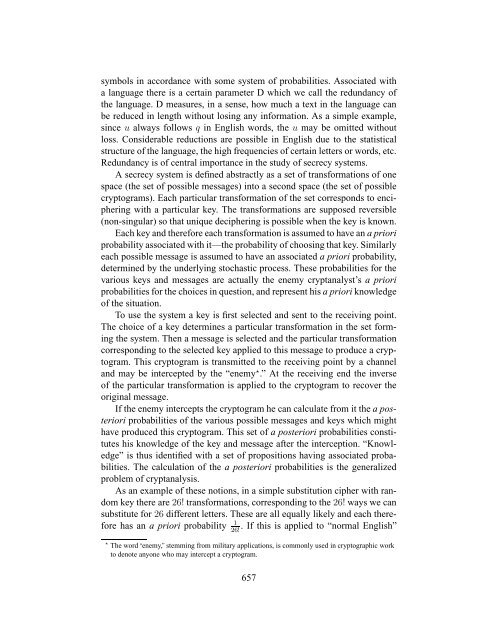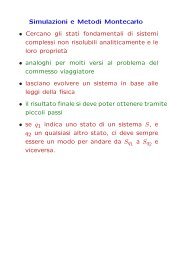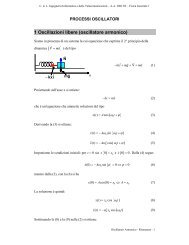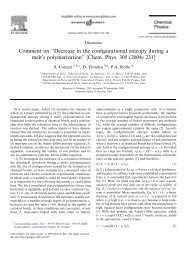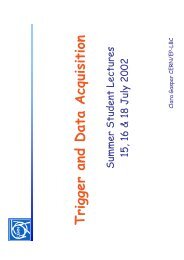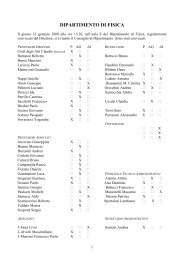Communication Theory of Secrecy Systems - Network Research Lab
Communication Theory of Secrecy Systems - Network Research Lab
Communication Theory of Secrecy Systems - Network Research Lab
You also want an ePaper? Increase the reach of your titles
YUMPU automatically turns print PDFs into web optimized ePapers that Google loves.
symbols in accordance with some system <strong>of</strong> probabilities. Associated with<br />
a language there is a certain parameter D which we call the redundancy <strong>of</strong><br />
the language. D measures, in a sense, how much a text in the language can<br />
be reduced in length without losing any information. As a simple example,<br />
since u always follows q in English words, the u may be omitted without<br />
loss. Considerable reductions are possible in English due to the statistical<br />
structure <strong>of</strong> the language, the high frequencies <strong>of</strong> certain letters or words, etc.<br />
Redundancy is <strong>of</strong> central importance in the study <strong>of</strong> secrecy systems.<br />
A secrecy system is defined abstractly as a set <strong>of</strong> transformations <strong>of</strong> one<br />
space (the set <strong>of</strong> possible messages) into a second space (the set <strong>of</strong> possible<br />
cryptograms). Each particular transformation <strong>of</strong> the set corresponds to enciphering<br />
with a particular key. The transformations are supposed reversible<br />
(non-singular) so that unique deciphering is possible when the key is known.<br />
Each key and therefore each transformation is assumed to have an a priori<br />
probability associated with it—the probability <strong>of</strong> choosing that key. Similarly<br />
each possible message is assumed to have an associated a priori probability,<br />
determined by the underlying stochastic process. These probabilities for the<br />
various keys and messages are actually the enemy cryptanalyst’s a priori<br />
probabilities for the choices in question, and represent his a priori knowledge<br />
<strong>of</strong> the situation.<br />
To use the system a key is first selected and sent to the receiving point.<br />
The choice <strong>of</strong> a key determines a particular transformation in the set forming<br />
the system. Then a message is selected and the particular transformation<br />
corresponding to the selected key applied to this message to produce a cryptogram.<br />
This cryptogram is transmitted to the receiving point by a channel<br />
and may be intercepted by the “enemy ⋆ .” At the receiving end the inverse<br />
<strong>of</strong> the particular transformation is applied to the cryptogram to recover the<br />
original message.<br />
If the enemy intercepts the cryptogram he can calculate from it the a posteriori<br />
probabilities <strong>of</strong> the various possible messages and keys which might<br />
have produced this cryptogram. This set <strong>of</strong> a posteriori probabilities constitutes<br />
his knowledge <strong>of</strong> the key and message after the interception. “Knowledge”<br />
is thus identified with a set <strong>of</strong> propositions having associated probabilities.<br />
The calculation <strong>of</strong> the a posteriori probabilities is the generalized<br />
problem <strong>of</strong> cryptanalysis.<br />
As an example <strong>of</strong> these notions, in a simple substitution cipher with random<br />
key there are 26! transformations, corresponding to the 26! ways we can<br />
substitute for 26 different letters. These are all equally likely and each there-<br />
. If this is applied to “normal English”<br />
fore has an a priori probability 1<br />
26!<br />
⋆ The word “enemy,” stemming from military applications, is commonly used in cryptographic work<br />
to denote anyone who may intercept a cryptogram.<br />
657


